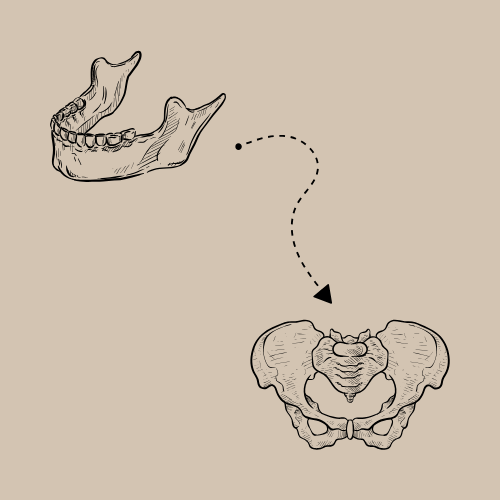Your Jaw Pain Isn’t Just About Your Jaw
Jaw pain might seem like a localized issue, but it’s rarely that simple. Unlike stubbing your toe, jaw discomfort often points to broader imbalances in the body. Your jaw is part of a highly interconnected system that includes your head, neck, shoulders and even your pelvis.
Common signs like clenching, popping, tension, or headaches are often labeled as TMJ or, more accurately, TMD (temporomandibular joint disorder). Many also experience bruxism, a grinding or clenching the teeth, especially during sleep or stress. But what if these symptoms are the result of something deeper, like poor posture, pelvic misalignment, or chronic tension patterns?
The Jaw–Pelvis Connection: A Fascial Relationship
Your body operates in integrated, mirrored patterns. The jaw and pelvis are two foundational hubs for both stability and movement. And while they may seem worlds apart, they’re more connected than you might think.
Both the jaw and the pelvis contain diaphragms:
· The floor of the mouth plays a key role in regulating intra-abdominal pressure, breath, and tension patterns throughout the upper body.
· The pelvic diaphragm supports vital organs and their function, aids in circulation, and helps maintain core stability.
When one diaphragm is under stress (clenching the jaw or chronic pelvic tension) the other often compensates. This interplay affects how we breathe, move, and even how we hold stress.
Fascia: The Body’s Hidden Web
Fascia is the connective tissue that links everything (muscles, bones, organs) into a continuous network. It transmits tension and movement, supports healing, and even stores emotional stress. So when one part of your body is out of balance, like your pelvis or posture, that tension can travel along the fascial lines and land somewhere seemingly unrelated. In this case - your jaw.
The Chain Reaction of Dysfunction
Think of it this way. If you badly stubbed your toe and never healed it correctly, your body would begin to adapt. It could change the way you walk which would affect your gait and eventually affect your knees, hips, or back. The same thing can happen with your jaw.
When the body compensates for imbalances due to lifestyle, injury, or habits, it creates tension elsewhere. For many people, that “elsewhere” becomes the jaw. Slouched posture, a tilted pelvis, or chronic core tension can all cascade upward through the fascia, showing up as clenching, pain, or misalignment in the jaw.
Managing vs. Solving Jaw Pain
Night guards, bite adjustments, and medication might offer short-term relief, but they don’t address the underlying cause. A night guard protects your teeth, not your clenching habit. Medication masks pain, but doesn’t correct posture or regulate the nervous system.
To truly resolve jaw pain, you need to look beyond the jaw itself.
Real Relief Starts at the Root
Many conventional treatments focus on the jaw in isolation. But if tension originates from postural imbalances, pelvic dysfunction, or nervous system dysregulation, those solutions won’t stick.
Pelvic floor therapy, combined with a full-body approach, can help uncover the root causes of chronic tension. By addressing the body as a whole, not just a single symptom, lasting relief becomes possible.


